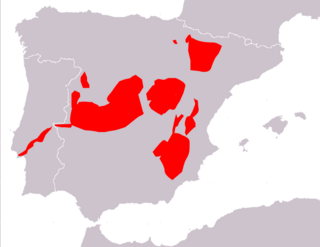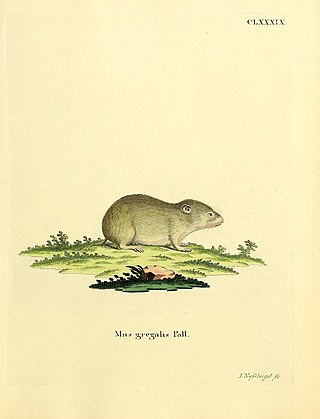
Voles are small rodents that are relatives of lemmings and hamsters, but with a stouter body; a longer, hairy tail; a slightly rounder head; smaller eyes and ears; and differently formed molars. They are sometimes known as meadow mice or field mice in North America.

The hoary marmot is a species of marmot that inhabits the mountains of northwest North America. Hoary marmots live near the tree line on slopes with grasses and forbs to eat and rocky areas for cover.

The North American water vole or just water vole is the largest North American vole. It is found in the northwestern United States and southern parts of western Canada. This animal has been historically considered a member of genus Arvicola, but molecular evidence demonstrates that it is more closely related to North American Microtus species. Water voles are on the USDA Forest Service Region 2 sensitive species list because they maintain very small populations and there is high concern that their required habitat may be declining.

The tundra vole or root vole is a medium-sized vole found in Northern and Central Europe, Asia, and northwestern North America, including Alaska and northwestern Canada. In the western part of the Netherlands, the tundra vole is a relict from the ice age and has developed into the subspecies Alexandromys oeconomus arenicola.

The northern red-backed vole is a small slender vole found in Alaska, northern Canada, Scandinavia and northern Russia.

The singing vole, is a medium-sized vole found in northwestern North America, including Alaska and northwestern Canada.

The long-tailed vole, in some areas known as the San Bernardino long-tailed vole, is a small vole found in western North America. They have short ears and a long tail. Their fur is gray brown with light gray underparts. They are around 18 cm (7.1 in) long with an 8 cm (3.1 in) tail and weigh about 50 g (1.8 oz).

The genus Phenacomys is a group of North American voles. The genus name comes from the Greek for "imposter mouse."

The western heather vole is a small vole found in western North America. Until recently, the eastern heather vole,, was considered to be a subspecies. They have short ears with stiff orange hair inside and a short thin tail which is paler underneath. Their long soft fur is brownish with silver grey underparts. They are roughly 14 cm (5.5 in) long with a tail length shorter than one-half their body length, approximately 50 mm (2.0 in). They weigh about 40 g (1.4 oz).

The eastern heather vole,, is a small North American vole. Until recently, this species was considered to belong to the same species as the western heather vole, Phenacomys intermedius. It is also called the Ungava vole.

The woodland vole is a small vole found in eastern North America. It is also known as the pine vole.

The prairie vole is a small vole found in central North America.

The California vole is a type of vole which lives throughout much of California and part of southwestern Oregon. It is also known as the "California meadow mouse", a misnomer as this species is a vole, not a mouse. It averages 172 mm (6.8 in) in length although this length varies greatly between subspecies.

The beach vole or Muskeget vole is a rodent in the family Cricetidae. This close relative of the eastern meadow vole is endemic to the 0.87 km2 Muskeget Island, Massachusetts. Due to its relatively short period of reproductive isolation, there is debate over the beach vole's designation as a subspecies of M. pennsylvanicus.

Cabrera's vole is a species of vole native to Spain and Portugal. It is named for Ángel Cabrera, a mammalogist then working at the Museo Nacional de Ciencias Naturales in Madrid. It is the only living member of the subgenus Iberomys, although two fossil species are also known, including M. brecciensis, the likely direct ancestor of the living species.

The narrow-headed vole is a species of rodent in the family Cricetidae. It was previously placed in the genus Microtus, but modern listings either lump this into genus Lasiopodomys or split it out into Stenocranius. It ranges over northern and central Asia.

The montane vole is a species of vole native to the western United States and Canada.
The Jalapan pine vole is a species of rodent in the family Cricetidae, found only in Mexico. The scientific name quasiater translates as "almost black", while the common name refers to the city of Jalapa, close to where the first specimen was collected.

The Mexican volcano mouse is a species of rodent in the family Cricetidae endemic to high elevation areas of the Trans-Mexican Volcanic Belt.
The common yellow-toothed cavy is a species of rodent in the family Caviidae, closely related to the domesticated guinea pig. It is found in Argentina, Bolivia, Chile, and Peru. Its karyotype has 2n = 68 and FN = 136. G. musteloides is the most common and widely found member of Galea, and is present at elevations ranging from 20 to 5000 m above sea level. It has yellow teeth.



















